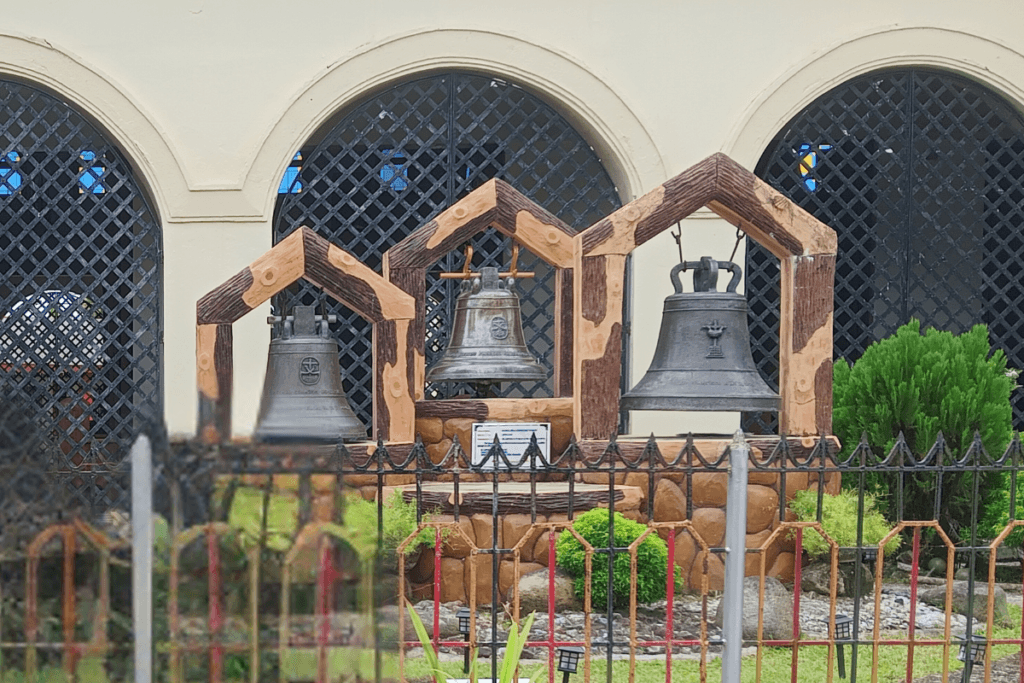Eastern Visayas, or Region 8, is home to a wealth of historical treasures. Each site has a story rooted in the resilience, faith, and bravery of its people. From centuries-old churches to wartime landmarks, these places offer a glimpse into the province’s unique past. Let’s explore the seven must-visit historical places in Samar.
7 Historical Places in Samar You Must Visit!
Balangiga Bells
495P+R6F, Balangiga, Eastern Samar

The town of Balangiga holds a significant chapter in Philippine history. The Balangiga Bells commemorate the Balangiga Massacre of 1901, a key event in the Philippine-American War. Filipino villagers attacked American soldiers, and in retaliation, the town was destroyed. The Americans took the bells as war trophies. For over a century, they remained in the United States.
In 2018, the bells were finally returned, symbolizing the enduring Filipino spirit and the long struggle for justice and independence. Today, they stand proudly in Balangiga, serving as a reminder of both tragedy and triumph.
Diocesan Shrine of St. Anthony of Padua
Sulangan, Eastern Samar

Popularly known as Sulangan Church, the San Antonio de Padua Church is a beautiful blend of Spanish and Filipino architecture.
Established in 1957, this church is a major pilgrimage site for devotees of St. Anthony of Padua. It holds a relic of the saint, brought from Italy in 2015. The church’s stunning facade, with its fluted pilasters and rose windows, adds to its charm.
For many pilgrims, visiting this church during Holy Week is part of the Visita Iglesia tradition, where they visit seven churches to pray and reflect. This timeless practice blends religious devotion with a deep appreciation of the church’s historical significance.
Immaculate Conception Parish Church
Guian, Eastern Samar

The Immaculate Conception Church, also known as Guiuan Church, is one of the most important historical structures in Eastern Samar. It was originally built by Jesuit missionaries in 1718 and is considered a National Cultural Treasure.
The church features beautiful Baroque architecture, with Corinthian columns and intricate carvings. Local artisans added unique touches, embedding seashells into the walls to reflect the coastal heritage of the region.
In 2013, Typhoon Yolanda (Haiyan) severely damaged the church, destroying its roof and facade. Restoration began in 2016, and the church was reopened in 2019. Today, the rebuilt church stands as a symbol of the community’s resilience and dedication to preserving their cultural heritage.
Cathedral Parish of Our Lady of Nativity
Borongan, Eastern Samar
(Photo: Alren Beronio Multimedia)
The Borongan Cathedral, dedicated to Our Lady of the Nativity, dates back to 1710. The Jesuits initially founded the church, but it passed through the hands of various religious orders over the centuries.
The original structure, built by Fr. Francisco Diez, was made of quarried stone. However, it was destroyed by fire in 1773. Fr. Roque de Osma reconstructed the church and later expanded it. Its bell tower, erected in 1853, is the only colonial-era structure still standing today.
Declared a heritage site in 1998, the cathedral remains a focal point of faith in Borongan City. Its history is a testament to the perseverance of the local community and their enduring spiritual devotion.
St. Michael the Archangel Parish Church
73JC+92P, Basey, Samar
(Photo: FB Lumang Simbahan)
St. Michael the Archangel Parish Church, commonly known as Basey Church, is a Spanish-era structure located in Basey, Samar.
Built by Jesuit missionaries in the late 17th century, it served as a mission station during Spanish colonization. The church features a bell tower with a polygonal design, and its portico is inscribed with “HAEC EST DOMUS DEI ET PORTA COELI,” meaning “This is the House of God and Gate of Heaven.”
The surrounding countryside adds to the serene atmosphere, making it a perfect spot for reflection.
Basey Church has played various roles throughout its history, including serving as a fortress and evacuation site during World War II. Its rich history and peaceful setting make it a must-visit for history enthusiasts and nature lovers alike.
Navy 3149 Base
Guiuan, Eastern Samar
(Photo: Janet Israel-Ramos)
The Navy 3149 Base in Ngolos, Guiuan, was a key site during World War II. Located 23 kilometers from the town proper, this base played a crucial role in the American war effort.
It was from this base that the B-52 bomber, “Enola Gay,” took off to drop the first atomic bomb on Hiroshima in 1945.
Today, the remnants of the base, including bunkers, tunnels, and gun emplacements, serve as a haunting reminder of the war. Visitors can explore the site, imagining the intense battles fought in this tranquil area. The nearby beach, with its white sand and stunning rock formations, contrasts sharply with the site’s war-torn history, offering a peaceful yet poignant experience.
Capul Lighthouse in Northern Samar
(Photo: Ron Camara)
Capul Lighthouse, perched on Titoog Point at the northern tip of Capul Island, has been guiding ships through the San Bernardino Strait since 1896.
Designed by Guillermo Brockman and supervised by Francisco Perez Muñoz, this cylindrical lighthouse is one of the few remaining functional lighthouses from the Spanish colonial era. It was declared a National Historical Landmark in 2013.
The lighthouse stands approximately 40 feet tall and offers breathtaking views of the surrounding landscapes, including Mount Bulusan, on clear days. Beyond its role as a navigational aid, the lighthouse is a symbol of the island’s maritime heritage, standing as a beacon of history and culture for visitors and locals alike.
Visit these historical places in Samar!
Samar’s historical landmarks are a testament to its rich and varied past. From colonial-era churches to wartime relics, these sites offer a glimpse into the resilience, faith, and courage of the people who lived here.
Each place tells a unique story woven into the fabric of Samar’s history. Visiting these historical places is not just a journey through time. It’s a chance to connect with the spirit of the province and its people.




